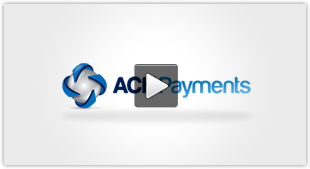ACH Processing Solutions
Outline:
- What is ACH Payment Processing?
- ACH Risk Mitigation
- Why a business should leverage ACH Payment Capabilities
- ACH Processing Solutions
- ACH API: Automate ACH Payments
- ACH Payment Transaction Flow
- What you should know about ACH Payment Processing
ACH Payment Processing: What Your Business Needs To Know
An ACH Processing Company offers businesses the ability to electronically debit [and credit] checking and savings accounts. ACH Payments are an especially attractive option for recurring payments billers.

In the US we have two main payment rails. One is credit/debit card processing and the second is the ACH Payment Processing network.
There is a major difference in how they work. Credit/debit card processing offers an authorization component. This means you can ascertain in near real-time that your customer has the requisite funds to be debited and place a hold on these funds. Essentially you know at the time of sale whether or not this customer pays you.
The ACH world operates in a batch environment where all transactions received on Monday get sent to the Federal Reserve for processing early Tuesday morning. The two banks involved have 48 hours to reconcile and settle the monies. There is a risk of the customer not having enough money or having a closed account or several other return reasons. This can be a drawback for businesses that accept one-time payments for goods or services. You would not want to ship a $1000 order until you knew funds were good.
ACH Risk Mitigation
There are risk mitigation tools to reduce your risk of accepting a “bad” check. The first checks that the bank account is open and in good standing via ACH Check Verification. This service tells you there is money in the bank account but does not tell you the blanace or if your $59 debit is covered.
The 2nd tool can provide a $ balance check as well as ascertain check writer’s history. The caveat is that the customer will need to log-in to their online bank platform. This could happen on your website via a pop up “lightbox”. Once the person log in you are able to tag along and check data points. This also provides Checking Account Owner Authentication, meaning you know if Suzy Jones owns the bank account she is providing.
ACH Payment Processing is an ideal solution for recurring billing.
So why should you use ACH Processing over Credit Cards?
Two BIG reasons.
First is the cost to process the payment. For recurring payments, you could expect to pay an average of 2.5% or more as total cost. So for every $100 customer debit you have $2.50 in fees. Cutting your margin by 2.5% can be difficult for businesses especially those in competitive commoditized industries.
In contrast, that same $100 transaction might cost a flat 30 cents as an ACH Payment.
So you save $2.20 per customer debit. Having 500 customers all on credit cards costs you over $10k per year more than an ACH option.
Second is payment rejects or declines. Let’s say we have 500 clients billed via credit cards on a monthly basis. Credit card declines routinely exceed 10% with 15% common.
Consider the business above billing 500 clients. 75 or so decline resulting in a revenue shortage of $7500/month or $90k per year. Sure effort [read $ costs] will be made to rebill but you can count on 2 things: 1-You are going to lose revenue and 2-You are going to lose customers you just could not collect from.
Contrast this with the ACH world. How many times in the past five years have you changed bank account? And how many new credit cards? You can see why decline rates are much lower, typically averaging around 2%. 15% versus 2%—BIG reason why an ACH Payment option is MUST HAVE for recurring billers.
To get started or to get more info Contact Us Today
ACH Processing Solutions
We offer multiple solutions to leverage ACH Payments:
1-ACH Virtual Terminal: Secure web based platform to set up recurring and one-time debits or credits. Complete reporting tool set and automated , customized email customer receipts
2-ACH Integration: Integrate an automated collections and reconciliation solution into your SaaS and create a stronger product your end users can’t do without.
3-ACH Website Payments: Simple, secure 24/7 payment collection options. Customize around you and your client needs.
4-ACH IVR Payments and ACH SMS Payments: Use Pay by Phone and Pay by Text payment collection tools to automate collection.
5- Advanced ACH Reconciliation Capabilities: Allows the platform to match bank deposits to client reporting tools.
We work with SaaS platforms looking to embed ACH processing solutions into their application. Using a feature-rich ACH API you can offer elegant payment and reconciliation solutions.
What Should a Business Look For in an ACH Integration API?
- Can you leverage the ACH Processing Integration for your apps’ revenue stream? If you offer your clients payment solutions your ACH partner should provide a revenue share
- Is there an API that would allow your customers to apply from your site or app?
- Other payment utilities available eg IVR and SMS payments?
- Does the platform meet PCI Security standards (though NACHA does not require ACH transactions to be PCI compliant)?
- Does the partner provide assistance in ACH payments processing adoption for you and your user clients?
- Does the ACH API offer additional utilities to make calls for anti-fraud and risk mitigation?
- For market bases that include Canada: does the partner provide a single API for both United States ACH and Canadian EFT?
- Is sensitive data tokenized?
- API availability: Does the partner offer RESTful or SOAP ACH transaction integration, or both?
- How long has your potential integration partner been serving the needs of app providers and what is their track record?
- Are there white label possibilities that might allow for a branded processing option, keeping the ACH processor behind the scene?
- Can risk acceptance models lower processing costs?
- Will your potential partner take the time to understand your business requirements and provide options that custom fit the payments needs to your needs and your clients?
Here is how a typical ACH transaction is processed from the perspective of you paying your Gym monthly membership via ACH:
On the first of each month, your fitness club tells his biller (the Originator-many times a Third Party Processor or an integrated software partner) to send a request to your bank to transfer $50 from your bank account to the fitness clubs account, per your written or online payment agreement.
The Originator sends this information to your bank, which deducts the $50 from your account and sends the information on to the ACH Operator (Third Party Processor-TPP). The $50 is still in your account, but no longer available to you, and is typically flagged as a “pending ACH debit”. Essentially, it’s a hold on that $50.
The ACH Operator notes that your bank is sending $50 and that the TPP on behalf of the fitness club is receiving $50, and makes the proper transaction notations (much like ledger entries).
At this point, no money has actually changed accounts-the ledgers show the $50 transaction but it’s all digital.
Until accounts are settled and the payment is “cleared” the transactions is not official.
What should you know about ACH Processing?
Pricing is typically a function of volume but you shouldn’t have to pay much more than .35 per transaction and in cases of high volume this can drop considerably. You should not be paying a discount rate in most cases except in higher risk categories. Returns (NSF etc.) should not be costing more than $5.00. Higher risk may change this. Monthly fees no more than $20-25.
Make sure your processor has been in business a few years and has some main-stream clients. A third party processor processing high risk transactions (telemarketing etc) can and has been be taken out of business by an unscrupulous company. Ask about some of their clients and front end tools. The better processors are always looking to make product improvements. Account verification is a major improvement. You can now ascertain if the check writer has a valid account with money in it before you take payment. Coupled with a processor with a strong collection program and you can dramatically reduce your risk of accepting bad checks.
Role of the Third Party Processor:
Most banks do not have the tools or resources to allow businesses to manage ACH transactions. That is where the Third Party Processor steps in.
The TPP you work with has a relationship with a bank to use their “Fedline”. This is the pipeline that carries transaction data to the Federal Reserve. The processor typically has a good amount of money on deposit with the bank to cover the bank’s risk. The advantage of working with a third party processor is that their front end tools e.g. software, Internet product or integration tools are much more user friendly than a bank.
ACH Processing Overview
Originally created to reduce paper check processing the ACH network began in the 1970’s and was predominately used to collect insurance premiums and mortgage payments in an automated fashion. Payroll direct deposit was and is another strong driver of ACH transaction volume. Today the ACH network processes billions of transactions each year and streamlines payment processing for 1000’s of businesses.
The ACH network consists of more than 12,000 financial institutions, 650 industry councils, and a network of regional ACH associations, and is governed by NACHA – The Electronic Payments Association in Herndon, Virginia. The National Automated Clearing House Association was established in 1974 to coordinate efforts to develop a nationwide ACH network, ultimately succeeding in 1978, when all ACH networks nationwide were electronically linked.
In 1980, the ACH Network was changed slightly by the passage of the Monetary Control Act, which allowed for private sector ACH Operators to compete with the Federal Reserve Bank.
To get started or to get more info Contact Us Today






